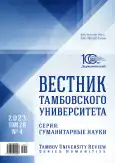Last fight of Alyosha Popovich
- Authors: Kozlov M.N.1, Boitsova E.E.1
-
Affiliations:
- Sevastopol State University
- Issue: Vol 28, No 4 (2023)
- Pages: 914-922
- Section: NATIONAL HISTORY
- URL: https://journal-vniispk.ru/1810-0201/article/view/298019
- DOI: https://doi.org/10.20310/1810-0201-2023-28-4-914-922
- ID: 298019
Cite item
Full Text
Abstract
Importance. Despite the fact that in our time the interest of Russian scientists in the history of Ancient Rus has significantly increased, some of its pages remain almost unexplored. For example, Alyosha Popovich, repeatedly mentioned in Ancient Rus’ chroniques and bylinas, remains for many modern researchers only a folklore character. Meanwhile, a detailed analysis of the key moments of the biography of the historical prototype of the bylina’s bogatyr will allow modern scientists to more deeply explore the historical processes that took place in the Ancient Rus’ society of the pre-Mongol era.Materials and methods. In the course of the research, special methods of cognition (historicalanalytical and problem-chronological) were used. The materials that form the basis of the research have been studied and analyzed taking into account the chronology of events, the need to obtain historical information from the scientific sources being studied. When comparing different theoretical views on the analyzed problems, the method of comparative and retrospective analysis was used. Chroniques and chronographs of the 15th–17th centuries, as well as Ancient Rus’ bylinas, the main character of which was Alyosha Popovich, became the basis of the source base of the research.Results and Discussion. Based on the analysis of Ancient Rus’ chroniques and chronographs, as well as the text of the folk bylina “Alyosha Popovich and Tugarin the Serpent”, the authors refuted the hypothesis that recently dominated in Russian science that Alyosha Popovich is a collective image of the ancient defenders of native land. The historical reconstruction of the biography of the most probable historical prototype of the bylina’s bogatyr is also presented.Conclusion. The main historical prototype of bylina’s bogatyr Alyosha Popovich was the Rostov warrior Alexander Popovich. He served in the druzhinas of the Old Russian knyazs Vsevolod Yuryevich and Konstantin Vsevolodovich and under their command participated in military campaigns and internecine wars.
About the authors
M. N. Kozlov
Sevastopol State University
Email: kmn_75@mail.ru
ORCID iD: 0000-0002-3535-8796
Scopus Author ID: 57210416383
ResearcherId: W-2469-2018
Dr. habil. (History), Professor of “Universal History and World Culture” Department
33 Universitetskaya St., Sevastopol, 299053, Republic of Crimea, Russian FederationE. E. Boitsova
Sevastopol State University
Author for correspondence.
Email: e.e.bojtsova@mail.sevsu.ru
ORCID iD: 0000-0001-8321-6162
PhD (History), Associate Professor, Head of “Universal History and World Culture”,
33 Universitetskaya St., Sevastopol, 299053, Republic of Crimea, Russian FederationReferences
- Alekseev S.V. (2020). Chronicle and bylina: how Aleksandr Popovich became Alyosha. Znanie. Ponimanie. Umenie = Knowledge. Understanding. Skill, no. 2, pp. 146-151. (In Russ.) https://doi.org/10.17805/zpu.20-20.2.13, https://elibrary.ru/eivgbx
- Mironov A.S. (2021). Bylina on the Russian frontier: deconstruction of the pre-Christian epic hero as a plot function of the folk epic “Alyosha Popovich and Tugarin the Serpent”. Kul’tura i tekst = Culture and Text, no. 1 (44), pp. 88-104. (In Russ.) https://doi.org/10.37386/2305-4077-2021-1-88-104, https://elib-rary.ru/wtsuvr
- Pesina E.A. (2020). Russian bogatyrs: mission possible. Social function of giftedness. Sotsial’nye yavleniya = Social Phenomena, vol. 10, no. 2, pp. 34-40. (In Russ.) https://doi.org/10.47929/2305-7327_2020.02_34-40, https://elibrary.ru/vzdsbw
- Kul’sarin N.G. (2014). Representation of heroes’ feats in Bashkir and Russian epos. Vestnik VEGU = Vestnik of Eastern Academy of Economics, Law and Humanities, no. 3 (71), pp. 172-176. (In Russ.) https://elib-rary.ru/sewihz
- Kloss B.M. (1968). Novyi pamyatnik russkogo eposa v zapisi XVI v. [A new monument of the Russian epos in the record of the 16th century]. Istoriya SSSR [History of the USSR], no. 3, pp. 151-157. (In Russ.) https://elibrary.ru/rhipzp
- Polyakov A.N. (2010). Druzhina v Drevnei Rusi [Druzhina in Ancient Rus]. Vestnik Orenburgskogo gosudarstvennogo universiteta = Vestnik of the Orenburg State University, no. 2 (108), pp. 41-46. (In Russ.) https://elibrary.ru/puzlun
- Lyzlov A. (1990). Skifskaya istoriya [History of the Scythians]. Moscow, Nauka Publ., 518 p. (In Russ.) https://elibrary.ru/smyqjf
- Tarasov I.M. (2019). Early Slavs and their neighbors in “History of the Scythians” by Andrei Lyzlov. Istoricheskii format = Historical Format, no. 2 (18), pp. 77-85. (In Russ.) https://elibrary.ru/hhrkkj
Supplementary files









